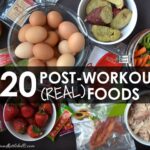You’ve crushed your workout. The endorphins are flowing, you feel strong, and you’re one step closer to your fitness goals. But what you do in the hours immediately following your training session is just as crucial as the workout itself.
This period, known as post-workout recovery, is where your muscles repair, rebuild, and grow stronger. Neglecting it can lead to plateaus, fatigue, and even injury.
This ultimate guide will walk you through the two pillars of effective recovery: proper nutrition and adequate rest. We’ll break down exactly what to eat, when to eat it, and why rest is non-negotiable for maximizing your gains.
Why Post-Workout Recovery is Non-Negotiable
Think of your muscles as a set of a thousand tiny ropes. During a tough workout, you create microscopic tears in these fibers. This isn’t a bad thing; it’s a necessary process for muscle growth (a concept known as hypertrophy). But for your muscles to rebuild stronger, they need the right fuel and time to heal. Without it, you’re essentially breaking down your body without giving it the chance to rebuild.
Proper recovery helps with:
- Muscle Repair and Growth: Supplying your body with the right nutrients helps repair damaged muscle fibers and build new ones.
- Replenishing Energy Stores: Intense exercise depletes your glycogen (stored carbohydrate) reserves. Replenishing them is key for future performance.
- Reducing Muscle Soreness: A well-structured recovery plan can help minimize Delayed Onset Muscle Soreness (DOMS), making your next workout more comfortable.
- Hormone Regulation: Recovery helps restore hormonal balance, especially cortisol (the stress hormone) levels, which are elevated during exercise.
Pillar 1: Post-Workout Nutrition – The Fuel for Growth
This is arguably the most critical part of your recovery. What you consume after a workout dictates how effectively your muscles can repair themselves. The “golden window” for post-workout nutrition is typically considered to be within 30-60 minutes after your workout, though recent research suggests the total daily intake is more important. Still, a well-timed recovery meal can kickstart the process.
The Two Key Macronutrients: Protein and Carbohydrates
Your post-workout meal should be a combination of two key macronutrients:
- Protein: Protein is the building block of muscle. Consuming protein after a workout provides your body with the amino acids it needs to repair those microscopic tears in your muscle fibers. Aim for 20-40 grams of high-quality protein.
- Good sources: Chicken breast, lean beef, fish (like salmon or tuna), eggs, Greek yogurt, cottage cheese, protein powder (whey or casein), or plant-based options like tofu, lentils, and chickpeas.
- Example: A scoop of whey protein in a shake, a chicken salad, or a cup of Greek yogurt.
- Carbohydrates: While protein rebuilds, carbohydrates refuel. Your body’s primary source of energy during a workout is glycogen, which is stored in your muscles and liver. Consuming carbs post-workout helps replenish these stores, preparing you for your next session. Aim for a 2:1 or 3:1 ratio of carbohydrates to protein.
- Good sources: Whole-grain bread, brown rice, sweet potatoes, oats, fruits (like bananas or berries), and quinoa.
- Example: A banana with your protein shake, oatmeal with berries, or a sweet potato with your chicken breast.
Don’t Forget About Hydration!
You lose a significant amount of water through sweat during exercise. Dehydration can impair muscle function and recovery. Make sure you rehydrate by drinking plenty of water or a sports drink with electrolytes. A simple rule of thumb is to weigh yourself before and after a workout; for every pound lost, drink about 16-24 ounces of water.
Pillar 2: Post-Workout Rest – The Time to Heal
While nutrition fuels the process, rest allows it to happen. Your muscles don’t grow during your workout; they grow when you’re at rest. Skimping on sleep and rest days can sabotage all your hard work.
The Importance of Sleep
Sleep is the ultimate recovery tool. It’s during deep sleep that your body releases Human Growth Hormone (HGH), which is vital for muscle repair and growth. Aim for 7-9 hours of quality sleep per night. Creating a consistent sleep schedule and a dark, cool environment can significantly improve your sleep quality.
Active Recovery vs. Passive Rest
Rest doesn’t always mean being completely sedentary. There are two types of rest you should incorporate into your routine:
- Passive Rest: This is your traditional rest day where you avoid intense exercise. This allows your body to fully heal from the stress of your workouts.
- Active Recovery: This involves low-intensity exercise that increases blood flow to your muscles, helping to reduce soreness and stiffness without adding extra stress. Examples include a light walk, stretching, foam rolling, or gentle yoga.
Listen to Your Body
This is perhaps the most important rule of all. Everyone’s recovery needs are different. If you’re feeling unusually sore, tired, or irritable, it’s your body’s way of telling you it needs more time to recover. Pushing through severe fatigue can lead to injury and burnout. Don’t be afraid to take an extra rest day or swap a tough workout for a lighter one.
A Sample Post-Workout Recovery Plan
- Immediately Post-Workout (within 30-60 minutes): A protein shake with a banana, or Greek yogurt with berries and a handful of nuts.
- A few hours later (your next meal): A balanced meal with lean protein, complex carbohydrates, and healthy fats. For example, grilled salmon with quinoa and roasted vegetables.
- Throughout the day: Drink plenty of water.
- Rest: Aim for at least one full rest day per week. Incorporate active recovery on your lighter days.
- Sleep: Prioritize 7-9 hours of quality sleep every night.
By paying equal attention to what you eat and when you rest, you’re not just recovering; you’re optimizing your body for peak performance, faster results, and long-term success in your fitness journey. Now go on, and give your body the care it deserves.

